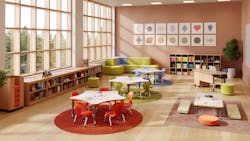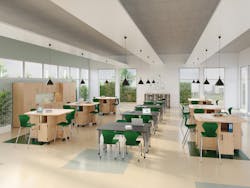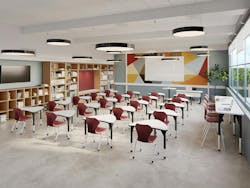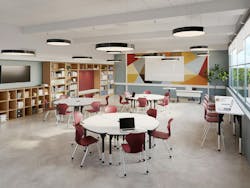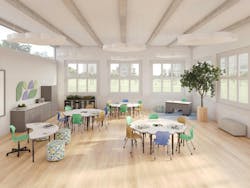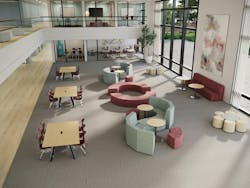Shaping Success: How Classroom Geometry Influences Student Engagement and Behavior
Key Highlights
- Flexible, shape-based layouts empower students with choices, increasing engagement and confidence, which can lead to higher test scores.
- Different shapes support specific learning activities: round tables for collaboration, triangles for small groups, and angular forms for focus and individual tasks
- Practical applications can include curved shelves in libraries, modular tables in STEM labs, and zones defined by shape rather than walls.
In today’s schools, flexibility, inclusivity, and student well-being aren’t just nice-to-haves—they’re non-negotiable. Yet one of the most powerful tools in creating these kinds of spaces is something many of us overlook: shape. How we shape a classroom can change the way students feel, behave, and engage.
Shape is a quiet force. You won’t find it shouting for attention, but it’s always working in the background—guiding how kids move, interact, and focus. Just like color and lighting affect mood and performance, shapes cue emotional and cognitive responses that we can use to our advantage when designing for learning.
The Psychology of Shape: What Our Brains Know Instinctively
Our brains are hardwired to respond to shape. Research shows that curves trigger the brain’s reward centers and make us feel safe and comfortable, as they remind us of nature and shelter. On the other hand, angles tend to cue alertness or caution, because they can signal danger or rigidity.
So, when you bring soft, organic shapes into a space—say, a circular rug or a kidney-shaped table—you’re dialing down the stress and inviting creativity and comfort. Rounded elements can help make a space feel more approachable and less institutional, especially for younger learners or those who need emotional support.
Match the Shape to the Learning
Here’s where design gets intentional. Different shapes naturally support different types of learning. For example:
- Round tables level the playing field; no head of the table means collaboration flows more easily.
- Triangular and petal shapes give students the space to work alone or in small clusters.
- Chevron and hex shapes support what’s called the Power of Pivoting: You can easily go from solo work to group projects without rearranging the entire room.
- Angular shapes like rectangles or trapezoids help reinforce structure and focus—perfect for individual tasks or testing.
Utilizing ‘Soft Boundaries’
Walls aren’t the only way to define space. In fact, they’re rarely the best way in a modern learning environment. “Soft boundaries”—like curved dividers, rugs, or even the orientation of tables—create visual cues that define different zones without creating isolation.
This is especially important in early education and for neurodiverse learners. They get the benefit of structure, but without feeling emotional pressure or becoming disengaged, results that can occur when they are placed in rigid or traditionally structured environments.
Plus, curved natural wayfinding paths strategically integrated within a classroom or other environments can help reduce stress, congestion, and confusion, as students can move more intuitively between quiet work, collaboration, and relaxation.
Shape + Choice = Inclusive Design
Shapes also help us support Universal Design for Learning (UDL). When students can choose between sitting on a cushion at a floor table, standing at a tall desk, or working at a round table with friends and classmates, they’re more likely to find what works best for them.
Diverse shapes can also give students greater control. This can include control over their posture and how they choose to interact or position themselves in a classroom. That control builds confidence and makes room for every kind of learner, especially those who struggle with traditional environments. In 2016, research from an industry leading organization found that shape-flexible classrooms led to 12% higher test scores and more student engagement. Flexible layouts give students a sense of control over how they learn, which is key to motivation.
What It Looks Like in Practice
These ideas aren’t just theoretical. Here’s how shape is already transforming learning spaces:
- Early education classrooms use organic forms, leaf-shaped rugs, and curved soft seating to foster safety and imagination.
- Libraries feature round reading nooks and curved shelves that invite students to explore.
- STEM spaces rely on modular tables with flexible shapes to shift quickly between lecture, project work, and lab time.
- Commons areas are designed with central zones for collaboration and peripheral zones for quieter breakout work—often signaled by shape and layout, not walls.
In all these spaces, shape is doing quiet but powerful work—inviting, guiding, and connecting.
Shape as a Direction
Shape is more than design—it’s direction. It tells students how to feel, where to focus, when to connect, and when to reflect. We know that curves can calm, clusters can connect, and modular forms can flex with the pace of learning. Whether it’s zoning for quiet focus or inviting collaboration through rounded tables, shape becomes a silent partner in every student’s experience.
When we design with intention—when we let learning take shape—we’re not just furnishing a space: We’re shaping behavior and opportunity. And that’s the power of environments designed to support every learner who walks through the door.
About the Author
Libby Ferin
Libby Ferin is the head of marketing for Marco, an American manufacturer of educational furniture products that helps create spaces where learning takes shape. She can be reached at [email protected].
